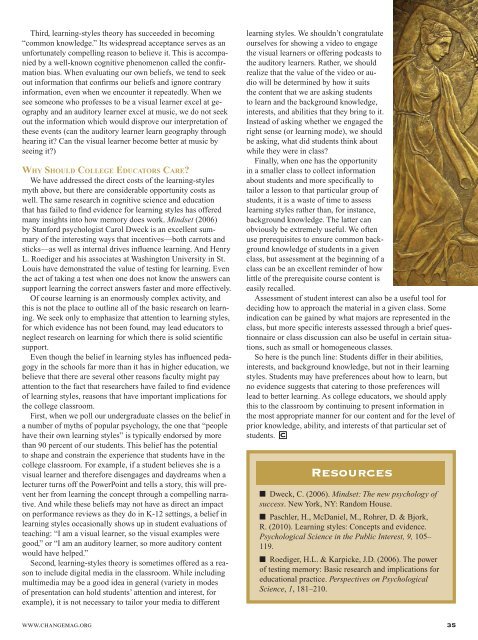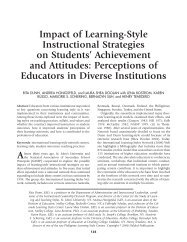THE MYTH OF LEARNING STYLES
The Myth of Learning Styles - People to People
The Myth of Learning Styles - People to People
- No tags were found...
Create successful ePaper yourself
Turn your PDF publications into a flip-book with our unique Google optimized e-Paper software.
Third, learning-styles theory has succeeded in becoming<br />
“common knowledge.” Its widespread acceptance serves as an<br />
unfortunately compelling reason to believe it. This is accompanied<br />
by a well-known cognitive phenomenon called the confirmation<br />
bias. When evaluating our own beliefs, we tend to seek<br />
out information that confirms our beliefs and ignore contrary<br />
information, even when we encounter it repeatedly. When we<br />
see someone who professes to be a visual learner excel at geography<br />
and an auditory learner excel at music, we do not seek<br />
out the information which would disprove our interpretation of<br />
these events (can the auditory learner learn geography through<br />
hearing it? Can the visual learner become better at music by<br />
seeing it?)<br />
Why Should College Educators Care?<br />
We have addressed the direct costs of the learning-styles<br />
myth above, but there are considerable opportunity costs as<br />
well. The same research in cognitive science and education<br />
that has failed to find evidence for learning styles has offered<br />
many insights into how memory does work. Mindset (2006)<br />
by Stanford psychologist Carol Dweck is an excellent summary<br />
of the interesting ways that incentives—both carrots and<br />
sticks—as well as internal drives influence learning. And Henry<br />
L. Roediger and his associates at Washington University in St.<br />
Louis have demonstrated the value of testing for learning. Even<br />
the act of taking a test when one does not know the answers can<br />
support learning the correct answers faster and more effectively.<br />
Of course learning is an enormously complex activity, and<br />
this is not the place to outline all of the basic research on learning.<br />
We seek only to emphasize that attention to learning styles,<br />
for which evidence has not been found, may lead educators to<br />
neglect research on learning for which there is solid scientific<br />
support.<br />
Even though the belief in learning styles has influenced pedagogy<br />
in the schools far more than it has in higher education, we<br />
believe that there are several other reasons faculty might pay<br />
attention to the fact that researchers have failed to find evidence<br />
of learning styles, reasons that have important implications for<br />
the college classroom.<br />
First, when we poll our undergraduate classes on the belief in<br />
a number of myths of popular psychology, the one that “people<br />
have their own learning styles” is typically endorsed by more<br />
than 90 percent of our students. This belief has the potential<br />
to shape and constrain the experience that students have in the<br />
college classroom. For example, if a student believes she is a<br />
visual learner and therefore disengages and daydreams when a<br />
lecturer turns off the PowerPoint and tells a story, this will prevent<br />
her from learning the concept through a compelling narrative.<br />
And while these beliefs may not have as direct an impact<br />
on performance reviews as they do in K-12 settings, a belief in<br />
learning styles occasionally shows up in student evaluations of<br />
teaching: “I am a visual learner, so the visual examples were<br />
good,” or “I am an auditory learner, so more auditory content<br />
would have helped.”<br />
Second, learning-styles theory is sometimes offered as a reason<br />
to include digital media in the classroom. While including<br />
multimedia may be a good idea in general (variety in modes<br />
of presentation can hold students’ attention and interest, for<br />
example), it is not necessary to tailor your media to different<br />
learning styles. We shouldn’t congratulate<br />
ourselves for showing a video to engage<br />
the visual learners or offering podcasts to<br />
the auditory learners. Rather, we should<br />
realize that the value of the video or audio<br />
will be determined by how it suits<br />
the content that we are asking students<br />
to learn and the background knowledge,<br />
interests, and abilities that they bring to it.<br />
Instead of asking whether we engaged the<br />
right sense (or learning mode), we should<br />
be asking, what did students think about<br />
while they were in class?<br />
Finally, when one has the opportunity<br />
in a smaller class to collect information<br />
about students and more specifically to<br />
tailor a lesson to that particular group of<br />
students, it is a waste of time to assess<br />
learning styles rather than, for instance,<br />
background knowledge. The latter can<br />
obviously be extremely useful. We often<br />
use prerequisites to ensure common background<br />
knowledge of students in a given<br />
class, but assessment at the beginning of a<br />
class can be an excellent reminder of how<br />
little of the prerequisite course content is<br />
easily recalled.<br />
Assessment of student interest can also be a useful tool for<br />
deciding how to approach the material in a given class. Some<br />
indication can be gained by what majors are represented in the<br />
class, but more specific interests assessed through a brief questionnaire<br />
or class discussion can also be useful in certain situations,<br />
such as small or homogeneous classes.<br />
So here is the punch line: Students differ in their abilities,<br />
interests, and background knowledge, but not in their learning<br />
styles. Students may have preferences about how to learn, but<br />
no evidence suggests that catering to those preferences will<br />
lead to better learning. As college educators, we should apply<br />
this to the classroom by continuing to present information in<br />
the most appropriate manner for our content and for the level of<br />
prior knowledge, ability, and interests of that particular set of<br />
students. C<br />
Resources<br />
n Dweck, C. (2006). Mindset: The new psychology of<br />
success. New York, NY: Random House.<br />
n Paschler, H., McDaniel, M., Rohrer, D. & Bjork,<br />
R. (2010). Learning styles: Concepts and evidence.<br />
Psychological Science in the Public Interest, 9, 105–<br />
119.<br />
n Roediger, H.L. & Karpicke, J.D. (2006). The power<br />
of testing memory: Basic research and implications for<br />
educational practice. Perspectives on Psychological<br />
Science, 1, 181–210.<br />
www.changemag.org 35





